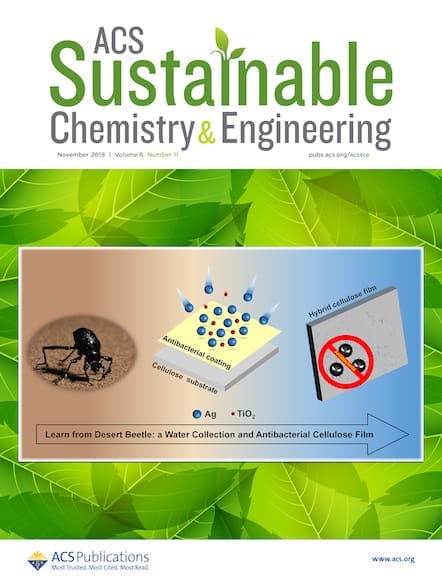Starting with stone mortars and pestles, before history was ever written, humans have ground and milled materials to induce physical or chemical changes. In the modern world, the systematic study of such processes has given rise to the field of mechanochemistry, set apart from its peers by the preferential use of solid-state reagents. At the […]

Starting with stone mortars and pestles, before history was ever written, humans have ground and milled materials to induce physical or chemical changes. In the modern world, the systematic study of such processes has given rise to the field of mechanochemistry, set apart from its peers by the preferential use of solid-state reagents. At the roots of mechanochemistry lies the ability of solids to support shear strain. Unlike fluids, sheared solids under stress experience a distortion of their crystalline structures. The resulting modification of crystal geometries can induce destabilization of chemical bonds in covalent, ionic, and metallic solids, and symmetry breaking in molecular solids, which can eventually cause chemical transformations.
Driven by scientists’ enthusiasm and by the promise of genuinely revolutionary impacts on the industrial preparation of fine chemicals and pharmaceuticals, mechanochemistry is slowly but steadily overcoming practical limitations (such as issues of scale-up), and its potential benefits are becoming ever more apparent. Mechanochemistry’s increased adoption promises a bright future of enhanced sustainability for the chemical industry, providing feasible solutions to realise the United Nations Sustainable Development Goals and the European Green Deal objectives.
In recent years, the use of mechanochemical methods to induce and alter chemical transformations has gained remarkable momentum, particularly in the field of organic synthesis. This Virtual Special Issue (VSI) concerning Advances in Mechanochemistry features contributions from prominent scientists in the area and is particularly focused on mechanochemical methods for enabling sustainable synthetic routes.
Learn more in the Degradable and Recyclable Virtual Special Issue Editorial.
Featured Articles:
Mechanochemical Cyclodehydrogenation with Elemental Copper: An Alternative Pathway toward Nanographenes
ACS Sustainable Chem. Eng. 2020, 8, 20, 7569–7573
DOI: 10.1021/acssuschemeng.0c02223
***
The Use of Copper and Vanadium Mineral Ores in Catalyzed Mechanochemical Carbon–Carbon Bond Formations
ACS Sustainable Chem. Eng. 2020, 8, 19, 7262–7266
DOI: 10.1021/acssuschemeng.0c02447
***
Mechanochemical and Mechanoenzymatic Synthesis of Pharmacologically Active Compounds: A Green Perspective
ACS Sustainable Chem. Eng. 2020, 8, 24, 8881–8893
DOI: 10.1021/acssuschemeng.0c01645
***
Solvent-Free Mechanochemical Synthesis of Ultrasmall Nickel Phosphide Nanoparticles and Their Application as a Catalyst for the Hydrogen Evolution Reaction (HER)
ACS Sustainable Chem. Eng. 2020, 8, 32, 12014–12024
DOI: 10.1021/acssuschemeng.0c02762
***
Solvent-Free, Continuous Synthesis of Hydrazone-Based Active Pharmaceutical Ingredients by Twin-Screw Extrusion
ACS Sustainable Chem. Eng. 2020, 8, 32, 12230–12238
DOI: 10.1021/acssuschemeng.0c03816
***
Efficient CO2 Sequestration by a Solid–Gas Reaction Enabled by Mechanochemistry: The Case of l-Lysine
ACS Sustainable Chem. Eng. 2020, 8, 35, 13159–13166
DOI: 10.1021/acssuschemeng.0c00217
***
Mechanochemistry Applied to the Synthesis of X-ray Contrast Agent
ACS Sustainable Chem. Eng. 2020, 8, 34, 12825–12830
DOI: 10.1021/acssuschemeng.0c02928
***
Environmentally Friendly Sunscreens: Mechanochemical Synthesis and Characterization of β-CD Inclusion Complexes of Avobenzone and Octinoxate with Improved Photostability
ACS Sustainable Chem. Eng. 2020, 8, 35, 13215–13225
DOI: 10.1021/acssuschemeng.0c02735
***
Making Agriculture More Sustainable: An Environmentally Friendly Approach to the Synthesis of Lignin@Cu Pesticides
ACS Sustainable Chem. Eng. 2020, 8, 39, 14886–14895
DOI: 10.1021/acssuschemeng.0c04645
***
Mechanochemically Activated Asymmetric Organocatalytic Domino Mannich Reaction-Fluorination
ACS Sustainable Chem. Eng. 2020, 8, 38, 14417–14424
DOI: 10.1021/acssuschemeng.0c04260
***
Mechanochemical Formation of Protein Nanofibril: Graphene Nanoplatelet Hybrids and Their Thermoelectric Properties
ACS Sustainable Chem. Eng. 2020, 8, 47, 17368–17378
DOI: 10.1021/acssuschemeng.0c05048
***
Mechanochemical Synthesis of Amides with Uronium-Based Coupling Reagents: A Method for Hexa-amidation of Biotin[6]uril
ACS Sustainable Chem. Eng. 2020, 8, 41, 15703–15715
DOI: 10.1021/acssuschemeng.0c05558
***
Enhanced Reactivity and Primary Liquid-Phase Forming in Mechanochemically Activated Soda–Lime–Silica Glass Batches
ACS Sustainable Chem. Eng. 2020, 8, 48, 17740–17751
DOI: 10.1021/acssuschemeng.0c05980
***
A Glove-Box- and Schlenk-Line-Free Protocol for Solid-State C–N Cross-Coupling Reactions Using Mechanochemistry
ACS Sustainable Chem. Eng. 2020, 8, 44, 16577–16582
DOI: 10.1021/acssuschemeng.0c05834
***
Mechanochemical Preparation of N,S-Doped Graphene Oxide Using (NH4)2SO4 for Supercapacitor Applications
ACS Sustainable Chem. Eng. 2020, 8, 51, 18810–18815
DOI: 10.1021/acssuschemeng.0c05918
***
Green Synthesis of Lidocaine Ionic Liquids and Salts: Mechanisms of Formation and Interactions in the Crystalline and Supercooled States
ACS Sustainable Chem. Eng. 2020, 8, 49, 18266–18276
DOI: 10.1021/acssuschemeng.0c06811
***
Mn(I)-Catalyzed Mechanochemical C–H Bond Activation: C-2 Selective Alkenylation of Indoles
ACS Sustainable Chem. Eng. 2020, 8, 51, 19105–19116
DOI: 10.1021/acssuschemeng.0c07465
***
Ultrasonication for Environmentally Friendly Preparation of Antimicrobial and Catalytically Active Nanocomposites of Cellulosic Textiles
ACS Sustainable Chem. Eng. 2020, 8, 51, 18879–18888
DOI: 10.1021/acssuschemeng.0c05493
***
Kabachnik–Fields Reaction by Mechanochemistry: New Horizons from Old Methods
ACS Sustainable Chem. Eng. 2020, 8, 51, 18889–18902
DOI: 10.1021/acssuschemeng.0c05744
***
Fast Li Ion Dynamics in the Mechanosynthesized Nanostructured Form of the Solid Electrolyte Li3YBr6
ACS Sustainable Chem. Eng. 2021, 9, 2, 743–755
DOI: 10.1021/acssuschemeng.0c06694
***
Multigram Mechanochemical synthesis of a Salophen Complex: A Comparative Analysis
ACS Sustainable Chem. Eng. 2021, 9, 3, 1152–1160
DOI: 10.1021/acssuschemeng.0c06374
***
Thermoelectric Cu–S-Based Materials Synthesized via a Scalable Mechanochemical Process
ACS Sustainable Chem. Eng. 2021, 9, 5, 2003–2016
DOI: 10.1021/acssuschemeng.0c05555
***
From Uncommon Ethylzinc Complexes Supported by Ureate Ligands to Water-Soluble ZnO Nanocrystals: A Mechanochemical Approach
ACS Sustainable Chem. Eng. 2021, 9, 4, 1540–1549
DOI: 10.1021/acssuschemeng.0c06081
***
The Mechanochemical Beckmann Rearrangement: An Eco-efficient “Cut-and-Paste” Strategy to Design the “Good Old Amide Bond”
ACS Sustainable Chem. Eng. 2021, 9, 5, 2100–2114
DOI: 10.1021/acssuschemeng.0c07254
***
Mechanochemical Synthesis and Thermal Dehydrogenation of Novel Calcium-Containing Bimetallic Amidoboranes
ACS Sustainable Chem. Eng. 2021, 9, 5, 2089–2099
DOI: 10.1021/acssuschemeng.0c06839
***
Mechanical Activation of Construction and Demolition Waste in Order to Improve Its Pozzolanic Reactivity
ACS Sustainable Chem. Eng. 2021, 9, 9, 3416–3427
DOI: 10.1021/acssuschemeng.0c05838
***
Biomechanochemical Solid-State Synthesis of Silver Nanoparticles with Antibacterial Activity Using Lichens
ACS Sustainable Chem. Eng. 2020, 8, 37, 13945–13955
DOI: 10.1021/acssuschemeng.0c03211
